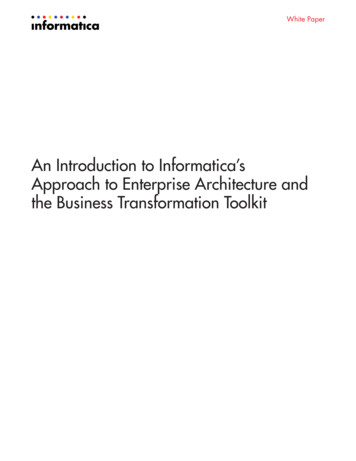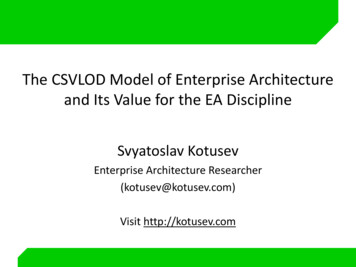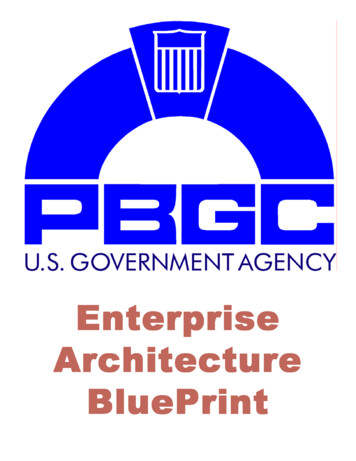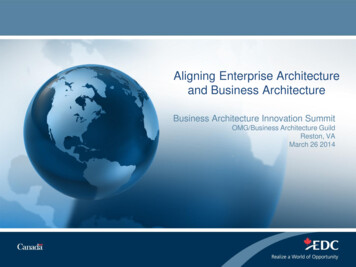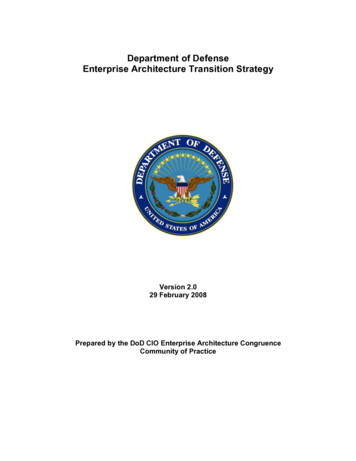
Transcription
Department of DefenseEnterprise Architecture Transition StrategyVersion 2.029 February 2008Prepared by the DoD CIO Enterprise Architecture CongruenceCommunity of Practice
Record of Changes from DoD EA Transition Strategy 28 Feb2007Change No.1. Changed versionnumbers and dates ofrelevant DoD documents2. Added User’s GuideSection3. Updated Introduction andNCE Sections with changesfrom the 2007 version4. Added relevant topics toCurrent Status Section,including expandeddiscussion of Net-Centricand other DoD Strategies5. Updated TargetCapability View section withGIG Architectural Visioncontent6. Updated TransitionStrategy Analysis section,using analysis of 65 DoD IT300 Exhibit investments asthe sample set7. Deleted RemediationSection and moved contentto Current Status section,and added SummarySection.Date of ChangeDate EnteredName of PersonEntering ChangeMarilee Cunningham,IDA31 December 200731 December 200718 January 200818 January 200831 December 200731 December 200731 December 200731 December 2007Marilee Cunningham,IDA31 December 200731 December 2007Marilee Cunningham,IDA31 December 200731 December 2007Marilee Cunningham,IDA31 December 200731 December 2007Marilee Cunningham,IDAiMarilee Cunningham,IDAMarilee Cunningham,IDA
Table of ContentsRECORD OF CHANGES FROM DOD EA TRANSITION STRATEGY 28 FEB 2007. IUSERS’ GUIDE.1SECTION 1. INTRODUCTION .2PURPOSE OF THE D EPARTMENT OF DEFENSE (DOD) ENTERPRISE A RCHITECTURE (EA) TRANSITION STRATEGY .2INTENDED AUDIENCE.2APPROACH TO DEVELOPMENT OF THE DOD EA TRANSITION STRATEGY .2SECTION 2. DOD NET-CENTRIC ENVIRONMENT (NCE) .5DESCRIPTION OF THE NCE .5SECTION 3. CURRENT STATE.9INTRODUCTION .10THE G LOBAL INFORMATION GRID ARCHITECTURE .10THE GIG AS A VISION, ENTITY, AND ARCHITECTURE .11DOD STRATEGIES .14DoD Strategic Plan .14DoD EA Federation Strategy.15DoD Portfolio Management.17Joint Capabilities Areas .18Joint Network Operations .19GIG Governance Structure Current and Planned.19DoD CIO Policies.21The GIG Architecture Drives Departmental Processes .22DOD NET-CENTRIC STRATEGIES .23DoD Net-Centric Data Strategy .24DoD Net-Centric Services Strategy.26DoD Information Sharing Strategy .27DoD Net-Centric Information Assurance (IA) Strategy.28DoD Net-Centric NetOps Strategy .28DoD Net-Centric Spectrum Management Strategy .28DoD Computing Infrastructure Strategy.29DOD INTERNET PROTOCOL VERSION 6 (IPV6) TRANSITION PLAN .29NET-CENTRIC ENTERPRISE SOLUTIONS FOR INTEROPERABILITY (NESI) .30ALIGNMENT WITH THE FEDERAL ENTERPRISE A RCHITECTURE .31INFORMATION SHARING ENVIRONMENT AND HOMELAND SECURITY PRESIDENTIAL DIRECTIVE -12 .32SEGMENT A RCHITECTURE .32Business Mission Area.32Business Transformation Transition Plan .33Defense Information Enterprise Architecture.33Warfighting Mission Area .33Intelligence Mission Area.34CROSS-AGENCY INITIATIVE SUMMARY .34Cross-Agency Initiative Tables .35OMB A SSESSMENT FRAMEWORK AND DOD EA ANNUAL PLAN .39DOD EA TRANSITION STRATEGY PROCESS AND ANNUAL U PDATE .40SUMMARY .41SECTION 4. TARGET CAPABILITY VIEW.42INTRODUCTION .42ii
OVERVIEW OF THE TARGET GIG.45THE O PERATIONAL BENEFITS OF A CHIEVING THE TARGET GIG .45SECTION 5. DOD EA TRANSITION STRATEGY CONCEPT AND COMPONENTS .57INTRODUCTION .57DOD EA TRANSITION STRATEGY COMPONENTS .58SECTION 6. DOD EA TRANSITION STRATEGY ANALYSIS.61INTRODUCTION .61COMPILED ANSWERS TO DOD EA TRANSITION STRATEGY Q UESTIONS .62PERFORMANCE INFORMATION ANALYSIS THAT SUPPORTS DOD EA TRANSITION PLANNING .68ANALYSIS OF STRATEGIC G OALS LINKED TO INVESTMENTS.69SUMMARY .69SECTION 7: DOD EA TRANSITION STRATEGY SUMMARY .71REFERENCES .73APPENDIX A: DOD EA ANNUAL PLAN. A-1APPENDIX B: DOD IT300 EXHIBITS’ MINI-TRANSITION STRATEGIES .B-1APPENDIX C. DOD IT300 EXHIBITS INVESTMENTS’ NET-CENTRIC CAPABILITIES PER NETCENTRIC MATURITY MODEL:. C-1APPENDIX D: DOD IT300 EXHIBIT INVESTMENTS’ PERFORMANCE INFO ANALYSIS . D-1APPENDIX E: CHART OF DOD IT300 EXHIBITS INVESTMENTS’ MISSION AREA, DOMAIN, LOBTO DOD STRATEGIC GOALS.E-1APPENDIX F: ARMY EA 2008 MINI-TRANSITION STRATEGY .F-1APPENDIX G: NAVY EA TRANSITION PLANNING .G-1APPENDIX H: BUSINESS MISSION AREA SEGMENT ARCHITECTURE OVERVIEW .H-1APPENDIX I: DEFENSE INFORMATION ENTERPRISE SEGMENT ARCHITECTURE OVERVIEW .I-1APPENDIX J: WARFIGHTING MISSION AREA SEGMENT ARCHITECTURE OVERVIEW . J-1iii
Table of FiguresFIGURE 1 – DOD EA RELATIONSHIP TO OMB FEA.13FIGURE 2 – FEDERATION ACROSS DOD COMPONENTS .16FIGURE 3. D OD INFORMATION ENTERPRISE .17FIGURE 4 – THE GIG LIFECYCLE .22FIGURE 5. D OD BUSINESS PROCESS WORKFLOW .27TABLE 1. PMA E-GOV INITIATIVE/LINE OF BUSINESS (LOB) .35TABLE 2. OTHER CROSS-AGENCY INITIATIVE LINE OF BUSINESS (LOB) .39FIGURE 6 – THE GIG ARCHITECTURE (THE DOD ENTERPRISE ARCHITECTURE) .44FIGURE 7 – TRANSITION FROM GIG ARCHITECTURE BASELINE TO GIG ARCHITECTURAL VISION .44FIGURE 8 – THE GIG AND NET-CENTRIC O PERATIONS .47FIGURE 9 – INFORMATION SHARING WITHIN THE TARGET GIG .48FIGURE 10 – SYSTEM VISION OF THE TARGET GIG .49FIGURE 11 – GIG INTERNETWORKING CONVERGENCE LAYER .50FIGURE 12 – GIG COMMUNICATIONS INFRASTRUCTURE .51FIGURE 13 – CONCEPTUAL VIEW OF AN E2E GIG WITH A BLACK CORE .54FIGURE 14 – GIG FEDERATED ARCHITECTURE APPROACH (N OTIONAL).55FIGURE 15 – GIG ARCHITECTURE V1.0, TRANSITION ARCHITECTURES (GIG V2.0, NET CENTRICITY, AND SOA) ANDTHE “TARGET” ARCHITECTURE (AS DESCRIBED BY THE GIG ARCHITECTURAL VISION) .57FIGURE 16 – DOD EA TRANSITION STRATEGY IN THE IT LIFECYCLE FRAMEWORK .58FIGURE 17 - CONCEPTUAL ENTERPRISE SEQUENCING PLAN .59FIGURE 18 – NET-CENTRIC PROGRESS BY FY AND QUARTER FOR DOD IT 300 EXHIBIT INVESTMENTS .66FIGURE 19 – RESPONDENTS NET-CENTRIC STATUS .67FIGURE 20. EXAMPLE USING ARMY W ARFIGHTER AND ENTERPRISE INFORMATION ENVIRONMENT (EIE) MISSIONAREA INVESTMENTS. .E-1FIGURE 21. EXAMPLE USING ARMY BUSINESS MISSION A REA INVESTMENTS. .E-2iv
Users’ GuideThe DoD Enterprise Architecture (EA) Transition Strategy 2008 follows the outline in theFederal Practice Guidance, November 2007, for developing a Transition Strategy andmeeting the criteria for the OMB EA Assessment. To help the reader to understand thedocument, a description of the sections and their content follows: Section 1. Introduction.This section describes the purpose, intendedaudience, and approach to developing the DoD EA Transition Strategy. Section 2. The DoD Net-Centric Enterprise. This section addresses theMission and Change Drivers of DoD and by outlining the Quadrennial DefenseReview (QDR) goals for transformation and the inherent need for a transitionstrategy to track progress toward the future Net-Centric Environment (NCE). Section 3: Current State. This section describes the progress the Departmenthas made architecting the complex Global Information Grid (GIG) and ongoingefforts. It includes the current status and summary content of the GIGArchitecture; DoD strategies and policies; GIG Governance; Mission AreaSegment Architectures; Internet Protocol v6; a cross-agency initiative summary;portfolio and capability management; and transition planning processes Section 4: Target Capability View.This section describes the GIGArchitectural Vision, the vision for the DoD “target” architecture for the NetCentric Environment (NCE). This is updated from the GIG Capstone descriptionin the DoD EA Transition Strategy 2007. Section 5: DoD EA Transition Strategy Analysis Concept and Components.This section .includes the what, why, and how as well as the elements of theDoD EA Transition Strategy. Section 6: DoD EA Transition Strategy Analysis. This section includes ananalysis of Mini-Transition Strategies, Net-Centric Maturity Models, andperformance information. The 65 DoD Component IT300 initiatives were used asa sample set to represent DoD transition planning. Section 7: DoD EA Transition Strategy Summary. This section restates theoutline of the document, ties together the sections, and presents the overallpicture that the DoD EA Transition Strategy is intended to convey.1
Section 1. IntroductionThis section describes the purpose, intended audience, and approach to developing theDoD EA Transition Strategy.Section 1 Contents: Purpose of the Department of Defense (DoD) Enterprise Architecture (EA)Transition Strategy Intended Audience Approach to Development of the DoD EA Transition StrategyPurpose of the Department of Defense (DoD) Enterprise Architecture (EA)Transition StrategyThe DoD EA Transition Strategy serves as the foundation to modernize and transformactivities by describing DoD’s plan to migrate from its 'baseline' architecture asdescribed in the federated GIG architecture to its 'target' architecture as outlined in theGIG Architectural Vision, by defining projects, programs, timelines and milestones in thecontext of transition and sequencing plans. Development of a DoD EA TransitionStrategy is mandated by the Office of Management and Budget (OMB) guidance whichtakes its authority from OMB Circular A-11, IT.300 Exhibits, OMB Circular A-130;Government Performance and Results Act (GPRA); the Clinger-Cohen Act, and the EGovernment Act and good management practice.Intended AudienceThe primary audience for the DoD EA Transition Strategy includes DoD executives andmanagers at all levels to include portfolio managers, strategic planners, resourcesplanners, strategic enterprise architects, internal organizations with cross-DoDcapability relationships, external organizations with cross-agency relationships with DoDprograms and projects, including OMB and the Government Accounting Office (GAO).Approach to Development of the DoD EA Transition StrategyTransformation is not only a goal for the Department of Defense to become moreeffective and efficient but it also connotes the continuous process improvement thatdoes not end with a set of specific accomplishments.The approach to development of the DoD EA Transition Strategy is to: educate and maintain currency of DoD community with regard to all aspects(policies, strategies, definition, etc) of EA; document required as-is, to-be, and associated transition strategies; require and monitor performance metrics;2
utilize periodic analyses of the aforementioned to realize continuous processimprovement and update of EA.The DoD EA Transition Strategy is an annual report that describes and updates all DoDefforts toward this continuous improvement process. The basic content reflects theOMB criteria for a transition strategy as outlined in the Federal Enterprise ArchitecturePractice Guidance, November 2007, and the DoD version, A Practical Guide forBringing Enterprise Architecture Value to the Mission, May 2007. In addition, OMB,through the OMB EA Assessment Framework, requires a transition strategy as a part ofthe DoD EA.Because of the large and complex Department of Defense with its multiple missions, theDoD EA Transition Strategy encompasses a federated approach to its development.For example, the Business Transformation Agency (BTA) 2007 Enterprise TransitionPlan (ETP) focuses specifically on the Business MA (BMA) and meets the criteria for anagency transition plan. The Enterprise Information Environment Mission Area (EIE MA)will publish an EA in January 2008 and plans to develop a Segment Architecture andTransition Strategy derived from the EA. The Warfighting MA (WMA), DefenseIntelligence MA (DIMA), and Intelligence MA (IMA) are also in the process of developingEAs and their related segment architectures and transition strategies. Projectedcompletion for the WMA and DIMA EAs is in late FY 2008/early FY 2009.Internet Protocol v6 (IPv6), has also developed a transition strategy, the IPv6 TransitionPlan V2.0, June 2006. In addition, as a sample set to exemplify DoD Components’transition planning, the 65 current Exhibit 300 investments have submitted MiniTransition Strategies to be used as a basis for analysis in this DoD EA TransitionStrategy,Using the DoD EA Annual Plan (embedded in Appendix A), a plan for that addressesEA progress as a guide, the DoD EA Transition Strategy accomplishes the following: Provides a repeatable process for creating, maintaining, and managing the DoDEA Transition Strategy, including processes for performing gap analysis,alternatives analysis, and the management of projects over time. Provides a mechanism for identifying opportunities for consolidation or reuse andgaps between the “baseline” and “target” architecture. Documents defined programs and projects and sequencing plans in support of itstarget architecture. Addresses priorities and performance objectives identified in the 2006 QDR. Includes initiatives with milestones for at least one segment architecture, theBusiness EA (BEA) for DoD’s Business Mission Area. Demonstrates clear linkage between Net-Centric capabilities in the TransitionStrategy and investments in the DoD investment portfolio.3
Includes defined and measurable performance milestones that indicate theDepartment’s success in achieving performance targets and has processes andtools in place to track performance. Identifies timelines for implementing net-centric attributes with supportingartifacts for investments in the IT300 Exhibit.The approach for developing this DoD EA Transition Strategy to address the complexDoD environment and meet the criteria for the OMB EA Assessment Framework,includes the following steps: Describe associations with the DoD transformation goals from the 2006 QDR Describe the status of DoD EA as a federated baseline architecture and thestatus of ongoing transformation efforts Describe the GIG Architectural Vision and related artifacts that comprise thefederated objective (target) architecture Analyze representative DoD IT300 Exhibit investments’ transition strategies andtheir performance measures to document transformation progress. Summarizefindings. Recommend an approach for continuous process improvement, including theDoD EA governance process and a DoD federated process that makes DoD NetCentric transformation information visible, accessible, and understandable.4
Section 2. DoD Net-Centric Environment (NCE)This section addresses the Mission and Change Drivers of DoD and by outlining theQuadrennial Defense Review (QDR) goals for transformation and the inherent need fora transition strategy to track progress toward the future Net-Centric Environment (NCE).Section 2 Contents: Description of the NCEDescription of the NCEThe DoD EA Transition Strategy links to the strategic goals of the Department asrepresented in the QDR 2006. These strategic goals cannot be accomplished without astrategy to transition from the existing environment represented by stove-piped systemsand islands of information to the desired NCE, and a commitment to the changesnecessary to accomplish the capabilities of the transformational NCE.The DoD leadership envisions the NCE as the underpinning of the many changesforeseen in the QDR 2006, which is a top-down look at US defense strategy, taking intoaccount the world environment, threats, current forces and programs, and the resourceslikely to be available. The Department foresees the need for continuous change, whichbuilds on the ever changing world in which the warfighter operates. The QDR maps theway ahead for the next 20 years as the Department confronts current and futurechallenges and continues its transformation for the 21st century.To characterize the nature of the Department’s transformation, it should be viewed as ashift of emphasis to meet the new strategic environment. Examples of this shift inemphasis include:1From a peacetime tempoFrom a time of reasonable predictabilityFrom single-focused threatsFrom nation-state threatsTo a wartime sense of urgencyTo an era of surprise and uncertaintyTo multiple, complex challengesTo decentralized network threats fromnon-state enemiesTo conducting war in countries we are notat war with (safe havens)To tailored deterrence for rogue powers,terrorist networks and near-peercompetitorsTo preventive actions so problems do notbecome crises (proactive)To shaping the futureTo capabilities based planningFrom conducting war against nationsFrom “one size fits all” deterrenceFrom responding after a crisis starts(reactive)From crisis responseFrom threat-based planning12006 Quadrennial Defense Review5
From peacetime planningFrom a focus on kineticsFrom 20th century processesFrom static defense, garrison forcesFrom under-resourced, standby forces(hollow units)From a battle-ready force (peace)From large institutional forces (tail)To rapid adaptive planningTo a focus on effectsTo 21st century integrated approachesTo mobile, expeditionary operationsTo fully-equipped and fully-manned forces(combat ready units)To battle hardened forces (war)To more powerful operational capabilities(teeth).From major conventional combatTo multiple irregular, asymmetricoperations –operationsFrom separate military Service concepts of To joint and combined operationsoperationFrom forces that need to de-conflictTo integrated, interdependent forcesFrom exposed forces forwardTo reaching back to CONUS to supportexpeditionary forcesFrom an emphasis on ships, guns, tanksTo focus on information, knowledge andand planestimely, actionable intelligenceFrom massing forcesTo massing effectsFrom set-piece maneuver and massTo agility and precisionFrom single Service acquisition systemsTo joint portfolio managementFrom broad-based industrial mobilizationTo targeted commercial solutionsFrom Service and agency intelligenceTo truly Joint Information OperationsCentersFrom vertical structures and processesTo more transparent, horizontal integration(stovepipes)(matrix)From moving the user to the dataTo moving data to the userFrom fragmented homeland assistanceTo integrated homeland securityFrom static alliancesTo dynamic partnershipsFrom predetermined force packagesTo tailored, flexible forcesFrom the U.S. military performing tasksTo a focus on building partner capabilitiesFrom static post-operations analysisTo dynamic diagnostics and real-timelessons learnedFrom focusing on inputs (effort)To tracking outputs (results)From Department of Defense solutionsTo interagency approachesThis shift in emphasis depends on the changes enabled by the NCE. Harnessing thepower of information connectivity defines Net-Centricity and serves as an underpinningof all other transformations. By enabling critical networked relationships betweenorganizations and people, the Department will be able to accelerate the speed ofbusiness processes, operational decision-making and subsequent actions due to better,more timely information. The collection and dissemination of information should bemanaged by portfolios of capabilities that cut across legacy stove-piped systems. Thesecapability portfolios require the identification of capability increments to measure6
progress toward the NCE and to address gaps, redundancies, and opportunities forreuse.The foundation for Net-Centric operations is the GIG, the target architecture describedin the GIG Architectural Vision that includes a globally interconnected, end-to-end set oftrusted and protected information networks. The GIG will enable the secure, agile,robust, dependable, interoperable data sharing environment for the Department wherewarfighter, business, and intelligence users share knowledge on a global network thatfacilitates information superiority, accelerates decision-making, effective operations, andNet-Centric transformation.The Department has made steady progress implementing Net-Centric systems andconcepts of operation. It has deployed an enhanced land-based network and newsatellite constellation as part of the Transformational Communication Architecture (TCA)to provide high-bandwidth, survivable internet protocol communications. Together, theysupport battle-space awareness, time-sensitive targeting and communicationscapabilities on the move. Deployed terminals – from command and control (JointTactical Radio System) to very large bandwidth ISR systems – are extending thecommunications “backbone” down to the smallest tactical unit in the field.Another foundation for Net-Centric operations is the DoD Net-Centric Data Strategyenabling the fusion of information from any platform or terminal. Pulling all this together,the revised Unified Command Plan has assigned U.S. STRATCOM lead responsibilityto operate and protect the GIG. To move closer toward this vision and build on progressto date, the Department will: Strengthen its data strategy – including the development of common datalexicons, standards, organization, and categorization – to improve informationsharing and information assurance, and extend it across a multitude of domains,ranging from intelligence to personnel systems. Increase investment to implement the GIG, defend and protect information andnetworks and focus research and development on its protection. Develop an information-sharing strategy to guide operations with Federal, state,local and coalition partners. Shift from Military Service-focused efforts toward a more Department-wideenterprise Net-Centric approach, including expansion of the Distributed CommonGround System. Restructure the Transformational Satellite (TSAT) prog
The DoD Enterprise Architecture (EA) Transition Strategy 2008 follows the outline in the Federal Practice Guidance, November 2007, for developing a Transition Strategy and meeting the criteria for the OMB EA Assessment. To help the reader to understand the document, a description of the sections and their content follows: Section 1. Introduction.

